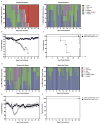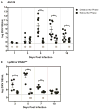A Mouse Model of Zika Virus Sexual Transmission and Vaginal Viral Replication
- PMID: 28009279
- PMCID: PMC5193244
- DOI: 10.1016/j.celrep.2016.11.070
A Mouse Model of Zika Virus Sexual Transmission and Vaginal Viral Replication
Abstract
Case reports of Zika virus (ZIKV) sexual transmission and genital persistence are mounting. Venereal transmission and genital persistence threaten public health within and beyond the range of ZIKV's mosquito vectors. In this study, we administered ZIKV into the vaginas of AG129 mice and LysMCre+IFNARfl/fl C57BL/6 mice after hormonal treatments. Mice infected during estrus-like phase were resistant to vaginal infection. In contrast, when infected during diestrus-like phase, AG129 mice succumbed to infection, whereas LysMCre+IFNARfl/fl mice experienced transient illness. Patency of transgenital transmission (TGT) in diestrus-like mice was demonstrated by detection of viremia and ZIKV replication in spleen and brain, and viral RNA persisted in vaginal washes as late as 10 days post-infection. In these lethal and sublethal mouse models, this study indicates that intravaginal deposition of ZIKV can cause TGT, hormonal changes in the female reproductive tract (FRT) influence transmission, and ZIKV replication persists in the FRT for several days.
Keywords: Zika virus; diestrus; genital; mouse model; semen; sexual; sperm; vagina; venereal.
Copyright © 2016 The Author(s). Published by Elsevier Inc. All rights reserved.
Conflict of interest statement
None.
Figures




Similar articles
-
Pathogenesis and sexual transmission of Spondweni and Zika viruses.PLoS Negl Trop Dis. 2017 Oct 6;11(10):e0005990. doi: 10.1371/journal.pntd.0005990. eCollection 2017 Oct. PLoS Negl Trop Dis. 2017. PMID: 28985234 Free PMC article.
-
Zika virus preferentially replicates in the female reproductive tract after vaginal inoculation of rhesus macaques.PLoS Pathog. 2017 Jul 26;13(7):e1006537. doi: 10.1371/journal.ppat.1006537. eCollection 2017 Jul. PLoS Pathog. 2017. PMID: 28746373 Free PMC article.
-
Maternal Zika Virus (ZIKV) Infection following Vaginal Inoculation with ZIKV-Infected Semen in Timed-Pregnant Olive Baboons.J Virol. 2020 May 18;94(11):e00058-20. doi: 10.1128/JVI.00058-20. Print 2020 May 18. J Virol. 2020. PMID: 32188737 Free PMC article.
-
Sexual transmission of Zika virus and other flaviviruses: A living systematic review.PLoS Med. 2018 Jul 24;15(7):e1002611. doi: 10.1371/journal.pmed.1002611. eCollection 2018 Jul. PLoS Med. 2018. PMID: 30040845 Free PMC article.
-
A new threat to human reproduction system posed by Zika virus (ZIKV): From clinical investigations to experimental studies.Virus Res. 2018 Aug 2;254:10-14. doi: 10.1016/j.virusres.2017.09.005. Epub 2017 Sep 8. Virus Res. 2018. PMID: 28893652 Review.
Cited by
-
Zika Virus Transmission Through Blood Tissue Barriers.Front Microbiol. 2019 Jul 4;10:1465. doi: 10.3389/fmicb.2019.01465. eCollection 2019. Front Microbiol. 2019. PMID: 31333605 Free PMC article. Review.
-
Maternally Acquired Zika Antibodies Enhance Dengue Disease Severity in Mice.Cell Host Microbe. 2018 Nov 14;24(5):743-750.e5. doi: 10.1016/j.chom.2018.09.015. Cell Host Microbe. 2018. PMID: 30439343 Free PMC article.
-
Gestational Stage and IFN-λ Signaling Regulate ZIKV Infection In Utero.Cell Host Microbe. 2017 Sep 13;22(3):366-376.e3. doi: 10.1016/j.chom.2017.08.012. Cell Host Microbe. 2017. PMID: 28910635 Free PMC article.
-
A Zika virus mutation enhances transmission potential and confers escape from protective dengue virus immunity.Cell Rep. 2022 Apr 12;39(2):110655. doi: 10.1016/j.celrep.2022.110655. Cell Rep. 2022. PMID: 35417697 Free PMC article.
-
Human Polyclonal Antibodies Prevent Lethal Zika Virus Infection in Mice.Sci Rep. 2019 Jul 8;9(1):9857. doi: 10.1038/s41598-019-46291-9. Sci Rep. 2019. PMID: 31285451 Free PMC article.
References
-
- Bielanski A, Algire J, Lalonde A, Garceac A. Embryos produced from fertilization with bovine viral diarrhea virus (BVDV)-infected semen and the risk of disease transmission to embryo transfer (ET) recipients and offspring. Theriogenology. 2013;80:451–455. - PubMed
-
- Braun U, Frei S, Schweizer M, Zanoni R, Janett F. Short communication: Transmission of border disease virus to seronegative cows inseminated with infected semen. Res Vet Sci. 2015;100:297–298. - PubMed
-
- Brooks JT, Friedman A, Kachur RE, LaFlam M, Peters PJ, Jamieson DJ. Update: Interim Guidance for Prevention of Sexual Transmission of Zika Virus - United States, July 2016. MMWR Morb Mortal Wkly Rep. 2016;65:745–747. - PubMed
Publication types
MeSH terms
Grants and funding
LinkOut - more resources
Full Text Sources
Other Literature Sources
Medical
Molecular Biology Databases
Research Materials

